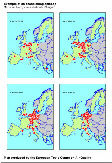4 MAIN
OZONE EPISODES
Ozone formation and destruction is
dependent on emissions, concentrations and ratios of precursors
(mainly VOC, CO and NOX), and on the amount and intensity of
sunlight. Important in this respect is the role of nitrogen oxide
emissions. In urban areas, the ozone concentrations may be lower
then the rural ('background') concentrations due to chemical
scavenging by local nitrogen oxide emissions (see for example
Figure 3, which shows that the occurrences of exceedances are in
general the highest at rural stations).
Episodes, periods with elevated ozone
levels, will mainly occur during periods of warm sunny weather.
In the Mediterranean countries, having prolonged spells of hot
and sunny weather during the summer, ozone can quickly be formed
and high levels can occur on many days and in the vicinity of
urban centres. In northern Europe the build up of ozone is slower
due to the more moderate weather conditions. Here, highest levels
will generally be found outside cities.
Figure 5 presents a graphical
representation of the percentage of stations in every Member
State that reported exceedances of the threshold value for
population information (180 µg/m3 for hourly values) during the
1996 summer season.
Figure 5: Qualitative overview of exceedances of
the 180 µg/m3 population information threshold value (1h) during
the period 1 April - 30 July 1996. The symbols represent the
percentage of stations which observed at least one exceedance of
the threshold for the information of the public during a
particular day
From Figure 5 it is clear that the number
of episodes covering extended areas of the European territory was
limited during summer 1996. As already mentioned in Section 3,
weather conditions in western and northern Europe were often
unfavourable for the build-up of ozone. On many days cool and
relatively clean Atlantic air masses prevailed in northern and
western European countries. Frontal activity could often be found
in the Alps region. One of the most widespread northern European
episodes this summer occurred 5-8 June 1996. Map 4 presents an
overview of the sites which observed an exceedance during this
period. In the text box, the conditions leading to this episode
are described in more detail. In contrast, in southern Europe
frequent exceedances are observed throughout the reporting
period.
The episode of
5-8 June 1996
On the first days of June, a high pressure cell formed
over western Europe. On 4 June, this pressure cell
dominated the weather north of the Alps. On that day, the
air mass present north of the Alps could be characterised
as relatively clean and cool Atlantic air. On 5 June, the
centre of the high pressure cell was situated near the
Baltic states. In western Europe, a light SE-circulation
set in which started to transport the air mass, which had
been present for a few days over the Continent, to the
North Sea basin. Under the influence of the intense solar
radiation, surface temperatures reached summerly values
and exceedances were observed in the BeNeLux, northern
France and southern UK. Hardly any exceedance was
observed in Germany on the 5th; here still cool Atlantic
air was present. On 6 June, temperatures reached 30 C at
many places and the area where exceedances occurred
extended to include the western part of Germany and parts
of Denmark. The number of exceedances in the Eastern part
of Germany was still limited. On 7 June a cold front,
behind which cooler and cleaner air moved in and reached
the western part of the UK; exceedances in the UK were
limited to the south-eastern part of the country. In the
hot air preceding the cold front (34 C was reached for
example in the Netherlands), thunderstorms developed
during the day in France and Belgium. Although there was
no change in air mass, the thunderstorms and more general
the build up of clouds ended the episode in France and
Belgium. More east, the area where ozone levels reached
the threshold now included eastern and northern parts of
Germany and the southern tip of Sweden. On 8 June, the
cleaner Atlantic air behind the cold front reached
France, BeNeLux and SW-Germany and subsequently no
exceedances were observed anymore in these regions. On 9
June, the cleaner and cooler air covered the whole of
Europe north of the Alps and no wide-spread exceedances
were reported anymore. Note that during the whole period
the weather was warm and sunny in southern Europe and
(occasional) exceedances were also reported from Spain,
Italy and Greece. |
 |
Map
4: Example of a smog
episode: stations which reported an hourly ozone
concentration in excess of 180 µg/m3, 5-8 June 1996 (all
station types). |
Figure 6 and 7 present the maximum hourly
ozone values recorded in the Athens conurbation (Greece) and in
Firenze (Florence, Italy), as examples of 'local' ozone episodes
in the Mediterranean region. Both in Athens and Firenze, the
threshold for warning of the public (1h >360 µg/m3) was
exceeded. Note that other stations in and around Athens did not
report exceedances during this period. More information on the
specific conditions leading to these particular episodes is not
yet available to the authors of this report.
Figure 6: Example of a local ozone episode,
Athens 18-22 May 1996. Maximum observed 1h values (µg/m3) on
stations in the Athens conurbation which observed an exceedance
of at least 180 µg/m3 (1h).
Figure 7: Example of a local ozone episode,
Firenze (Florence) (I),7-13 June 1996. Maximum observed 1h values
(µg/m3) on stations which observed an exceedance of at least 180
µg/m3 (1h).


Document Actions
Share with others